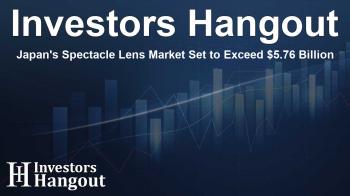Japan's Spectacle Lens Market Set to Exceed $5.76 Billion

Overview of Japan's Spectacle Lens Market Growth
The spectacle lens market in Japan is on an exciting trajectory, with projections indicating a rise from approximately US$ 3.31 billion in 2024 to an impressive US$ 5.76 billion by 2033. This growth corresponds to a compound annual growth rate (CAGR) of 6.35%. With a thriving network of around 28,500 opticians and 120 dedicated manufacturing facilities, the industry showcases significant consumer engagement and technological innovation.
Key Market Insights and Industry Drivers
The expectations of increased production in Japan are supported by robust advancements in lens manufacturing technology. Averaging 45 million units produced annually, the spectacle lens industry is fueled by a strong consumer base. One notable statistic reveals that first-time wearers typically start using spectacles around the age of 12, fostering a long-term relationship with the product. Additionally, Japan's 15 optometry schools contribute to this by producing 1,200 new graduates each year, bolstering the workforce required in this technical field.
Market Dynamics and Trends Shaping Demand
The lens replacement rate stands at approximately every 18 months, indicating a steady demand cycle. Consumers not only replace lenses regularly, but they also benefit from the diverse customization options available, with around 1,500 distinct designs catering to varied preferences. State-of-the-art production facilities are equipped with advanced lens coating machines, enhancing durability and product variety.
Technological Advancements and Consumer Preferences
With technological innovation at its core, the Japanese spectacle lens market continues to integrate sophisticated solutions that elevate user experience. The average lifespan of spectacle lenses is around 2.5 years, supported by a range of coatings aimed at improving durability. Special coatings such as anti-reflective and scratch-resistant finishes further distinguish the products available to consumers.
Operational Efficiency and Sustainability Practices
The spectacular lens market's operational efficiency is indicative of the industry’s commitment to sustainability. With imports of high-quality raw materials reaching about 10,000 tons annually, manufacturers emphasize not only performance but environmental responsibility as well. Recycling efforts have led to the establishment of 30 dedicated facilities that recover around 1,000 tons of materials each year, showcasing a step towards reducing environmental impact.
Growth Opportunities Through Digital Transformation
The ongoing digitization of retail and distribution channels is likely to reshape customer engagement strategies. The increase in mobile apps dedicated to lens management reflects consumers' growing desire for interactive and informative engagement. Such adaptations are expected to bolster sales and streamline service efficiency in a highly competitive landscape.
Challenges Faced by the Industry
Despite the promising outlook, the spectacle lens market encounters various challenges, such as rapidly evolving consumer needs and high innovation standards. Manufacturers face the pressure of sustaining production efficiencies while simultaneously adapting to customizable demands. The lens segment must navigate complexities erected by increasing ocular strain associated with extended screen time, a growing concern among consumers.
Investment in Research and Development
Investment in research is paramount, with approximately ¥5 billion dedicated annually to technological improvements. This commitment manifests in the development of new lens designs, further enhancing customer satisfaction levels and solidifying Japan's position as a global leader in lens innovation.
Conclusion: The Road Ahead for Japan's Spectacle Lens Market
The future of Japan’s spectacle lens market is bright as companies align their strategies to focus on sustainability, technological innovations, and a seamless consumer experience. Emphasis on quality control, rapid service delivery, and intensive training for opticians reinforce a profound commitment to excellence. As the landscape evolves, staying abreast of market trends and adapting to customer expectations will be vital for all stakeholders involved.
Frequently Asked Questions
What is the current value of the Japan spectacle lens market?
The Japan spectacle lens market was valued at approximately US$ 3.31 billion in 2024.
What is the projected growth for the spectacle lens market by 2033?
It is expected to reach US$ 5.76 billion by 2033, with a CAGR of 6.35%.
What are the key factors driving market growth?
Driving factors include strong consumer engagement, advanced manufacturing technologies, and a focus on customization.
How often do consumers replace their spectacle lenses?
On average, consumers tend to replace their spectacle lenses every 18 months.
What are the challenges faced by the spectacle lens market?
Challenges include rapidly evolving consumer preferences and the need for continuous innovation in product offerings.
About The Author
Contact Dylan Bailey privately here. Or send an email with ATTN: Dylan Bailey as the subject to contact@investorshangout.com.
About Investors Hangout
Investors Hangout is a leading online stock forum for financial discussion and learning, offering a wide range of free tools and resources. It draws in traders of all levels, who exchange market knowledge, investigate trading tactics, and keep an eye on industry developments in real time. Featuring financial articles, stock message boards, quotes, charts, company profiles, and live news updates. Through cooperative learning and a wealth of informational resources, it helps users from novices creating their first portfolios to experts honing their techniques. Join Investors Hangout today: https://investorshangout.com/
The content of this article is based on factual, publicly available information and does not represent legal, financial, or investment advice. Investors Hangout does not offer financial advice, and the author is not a licensed financial advisor. Consult a qualified advisor before making any financial or investment decisions based on this article. This article should not be considered advice to purchase, sell, or hold any securities or other investments. If any of the material provided here is inaccurate, please contact us for corrections.

